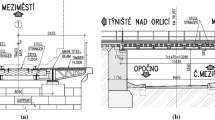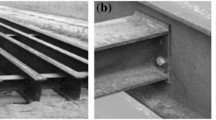Abstract
Through the detection of the steel structure bridge for 7 years, the main distribution of cracks in steel box girder of steel structure bridge was presented. Through the numerical analysis of the steel box girder of steel structure bridge, the stress distribution of the diaphragms was obtained. The result of detection and the numerical analysis was compared, and showed that the cracks mainly appeared in the welding parts and the arc notch of the diaphragms. The cracks at the welding part mainly came from the welding defects. And the cracks at the arc notch of the diaphragms were due to the stress concentration.
You have full access to this open access chapter, Download chapter PDF
Similar content being viewed by others
Keywords
1 Introduction
Steel box girders are made of top plate, bottom plate, web plate, diaphragm, longitudinal spacer and stiffening ribs connected by full welding. The structure welded by top plate, longitudinal ribs and diaphragm is called orthotropic steel bridge panel. The longitudinal ribs are divided into two structural forms, including mouth ribs and closed ribs. According to statistics, the longitudinal ribs of orthotropic steel bridge panels used in steel box girders in recent years are mostly in the form of closed ribs, especially U-shaped ribs [1].
At the intersection of the U-shaped rib and the diaphragm, the diaphragm is perforated, and the U-shaped rib continuously passes through the diaphragm. All the joints are welded, including the joints between the diaphragm and the top plate, the U-shaped rib and the diaphragm, the U-shaped rib and the top plate. In order to release the vertical deformation of the U-shaped rib, a certain gap is left between the bottom surface of the U-shaped rib and the diaphragm. The complex stress at the bottom of the U-shaped rib is avoided, the out plane deformation of the diaphragm is reduced. And the stress distribution of the entire orthotropic steel deck is more clear. [2, 3].
The damages of steel bridges due to insufficient strength rarely occur, but the fatigue damages are common appeared to cause failures of structures. Fatigue cracking is an important and direct manifestation of fatigue damage. Crack inspection is also an important indicator to measure the technical condition of a bridge when following up on steel bridges during operation.
2 Crack Disease Inspection
After a steel bridge is put into operation, the overall performance of the bridge will gradually deteriorate as the service time grows, so regular inspection of the bridge is required. The appearance of bridge defects will directly affect the safety and durability of steel bridges, of which cracking is one of the main forms of steel bridge defects.
From 2012 to 2018, a seven-year follow-up inspection was conducted on a large-span suspension bridge in China. The bridge had a stiffened steel box girder with a welded connection for the main girder. Cracking, as one of the important indicators of the operational condition of steel bridges, was statistically collated for each inspection. According to the occurrence of cracks, all cracks of the steel box girders were classified into 5 categories: (I) cracks at the joint between U-shaped ribs and top plates; (II) cracks at the intersection between the diaphragm and U-shaped ribs (lower root welding areas); (III) cracks at the curved notch of the diaphragm; (IV) cracks at the butt joint of U-shaped ribs; (V) cracks at the joints between the diaphragm, U-shaped ribs and the top plate (upper welding area of the diaphragm).
The addition of the five types of cracks is shown in Table 1, and the development of the original cracks is shown in Table 2 and Fig. 1.
Based on the results of the bridge’s 7-years follow-up inspection, the following conclusions can be drawn:
-
(1)
The number of IV cracks was the lowest and the extension was not obvious. The number of II cracks was the largest. The number of cracks in the steel box girder was increased with the growth of service time, and the cracks had been extended.
-
(2)
According to the crack disease inspection results, the crack occurrence sites can be summarized into two categories, one is the welding site, and the other is the curved cutout of the cross-sectional plate (non-welding site). Due to the limitation of structural deformation by the welding connection method and the residual stresses and welding defects that easily appear during the welding process, the welded parts of the steel box girder are prone to fatigue cracking.
-
(3)
In order to determine the reason for the ease of fatigue cracking at the curved cutout (non-welded part) of the diaphragm, further research and analysis using numerical analysis methods is required.
3 Numerical Analysis of the Diaphragm
3.1 Finite Element Model
The numerical analysis model was established using finite elements to analyze the forces on orthotropic anisotropic steel bridge panels.
According to the literature [2, 4], the structural systems of orthotropic steel bridge panels can be divided into three types, and the stresses in the second and third systems are usually the main factors causing fatigue problems in orthotropic steel bridge panels.
In order to obtain the stress state of the diaphragm of the steel box girder, a finite element numerical model was established using the second system consisting of U-shaped ribs, diaphragm and top plate, and the relevant parameters of the numerical model were as follows [5,6,7,8].
Bridge deck (top plate): the top plate was 15.6 m (i.e. the spacing between 6 diaphragms). 3 U-shaped ribs were a calculation unit (150 mm + 300 × 5 mm + 150 mm). 5 calculation units were the width of the top plate, i.e. 9 m, and the thickness of the bridge deck plate was 16 mm.
U-shaped ribs: the upper part was 300 mm wide, the lower part was 180 mm wide, the rib thickness was 8 mm, the U-shaped rib spacing was 300 mm, the length was 15.6 m, the same as the length of the top plate.
The diaphragm: the width of the diaphragm was 9 m, the same width of the top plate. The height was 1000 mm, the thickness was 12 mm, the spacing of the diaphragm was 3120 mm, the diaphragm in the corresponding part with the bottom of the U-shaped ribs into an arc cut, the bottom of the U-shaped ribs and the diaphragm to leave a gap of 25 mm.
The diaphragm acted as a vertical support for the top plate and U-shaped ribs. The diaphragm connected the top plate, U-shaped ribs and the bottom plate. The 4-node shell unit with 6° of freedom at each node was used in the calculation, the effect of large deformation effect was considered.
The boundary: all degrees of the diaphragm were fixed. The both sides of the diaphragm limited the displacement in the X and Y directions only.
The fatigue load model of Technical Specification for Design and Construction of Orthotropic Steel Bridge Deck of Highway Steel Bridge was used. The transverse distance of the two wheel loads was 2 m. A wheel load was 120 KN, and the load area was 0.6 × 0.2 m. In order to reflect the stress state of the boundary, the loads were applied on the top plate directly to the position of the diaphragm, symmetrically distributed in the centerline of the top panel (Fig. 2).
In the paper, the force characteristic of the diaphragm was focused on. In order to improve the computational efficiency, different meshing accuracy was used for the top plate, the U-shaped ribs and the diaphragms when dividing the cells. The top plate had a rectangular shape, so the coarsest cell mesh was used. The U-shaped ribs are curved, so a slightly more precise cell mesh was used than that of the top plate. The arc cut resulted in an irregular shape of the diaphragms, so the diaphragms required a finer grid of cells.
3.2 Finite Element Analysis Results
From the numerical analysis results, the stress state of diaphragms is extracted (Fig. 3). The top part of the diaphragms connected to the top plate is directly transferred the load to the diaphragms. The stress is higher at both ends than at the middle part. The left and the right sides of the cutout are subjected to the load transferred from the U-shaped ribs, and the stress is higher due to the influence of the welded connection, which restricts the out-of-plane displacement of the diaphragms, and the curved cutout is the largest part of the diaphragms, where there is an obvious stress concentration.
The above numerical analysis results are consistent with the fatigue cracks of the diaphragms in the second part of the bridge tracking inspection results. Therefore, in addition to fatigue cracking in the welding area, the curved cutout area of the spacer is also susceptible to fatigue cracking due to the existence of the stress concentration phenomenon.
4 Conclusions
In this paper, the main distribution parts and distribution rules of steel box girder cracks in steel bridges were obtained through a continuous 7-year follow-up inspection of large span steel bridges during the operation period, and according to the results of the follow-up inspection, the crack-prone parts of steel box girder were the welding parts of steel box girder and the diaphragms cutout.
The numerical analysis of the steel diaphragms was obtained, and the results showed that the diaphragms had obvious stress concentration phenomenon, which was the main cause of fatigue cracks at the diaphragms cutout, and the numerical analysis results were consistent with the bridge inspection results.
References
Zhu J (2020) Fatigue performance analysis of orthotropic steel bridge deck weld of rail-highway bridge. Nan**g Forestry University 06
Tong L, Shen Z, Chen Z (1998) Structural analysis of orthotropic steel bridge deck during fatigue checking. Shanghai Mech 19(3):204–212
Ke L, Lin J, Li C (2017) Fatigue performance and structural optimization of steel box girder diaphragm with arc notch. Bridge Constr 47(5):18–23
Liu X, Tao X, Zhang Y (2010) Theoretical analysis and research on orthotropic steel bridge deck system and structure. In: Bridge steel structure branch of china steel structure association 274–278
Yu H, Zhang N (2021) Finite element analysis of structural stress of orthotropic steel bridge deck system. Sichuan Archit 12:187–193
Tao X, Liu X, Zhang Y (2020) Research on stress characteristics of orthotropic steel bridge deck. Steel Struct. 7:12–14
Du B, Xu Z, Zhou W, Zhong Z (2022) Journal of Chongqing Jiaotong University (Natural Science edition) 1:59–66
Lv Z, Xu J, Qiang X, Wang X (2021) Structural Engineering 12:163–171 (in Chinese)
Acknowledgements
This work was financially supported by Central Public-Interest Scientific Institution Basic Research Fund (2021–9049a and 2021–9049b) and Open Project of National Engineering Laboratory of Bridge Safety and Technology (Bei**g).
Author information
Authors and Affiliations
Corresponding author
Editor information
Editors and Affiliations
Rights and permissions
Open Access This chapter is licensed under the terms of the Creative Commons Attribution 4.0 International License (http://creativecommons.org/licenses/by/4.0/), which permits use, sharing, adaptation, distribution and reproduction in any medium or format, as long as you give appropriate credit to the original author(s) and the source, provide a link to the Creative Commons license and indicate if changes were made.
The images or other third party material in this chapter are included in the chapter's Creative Commons license, unless indicated otherwise in a credit line to the material. If material is not included in the chapter's Creative Commons license and your intended use is not permitted by statutory regulation or exceeds the permitted use, you will need to obtain permission directly from the copyright holder.
Copyright information
© 2023 Crown
About this chapter
Cite this chapter
Ma, R., Dong, P., Xv, Z. (2023). Analysis on Fatigue Crack of Orthotropic Steel Bridge Decks. In: Yang, Y. (eds) Advances in Frontier Research on Engineering Structures. Lecture Notes in Civil Engineering, vol 286. Springer, Singapore. https://doi.org/10.1007/978-981-19-8657-4_26
Download citation
DOI: https://doi.org/10.1007/978-981-19-8657-4_26
Published:
Publisher Name: Springer, Singapore
Print ISBN: 978-981-19-8656-7
Online ISBN: 978-981-19-8657-4
eBook Packages: EngineeringEngineering (R0)







